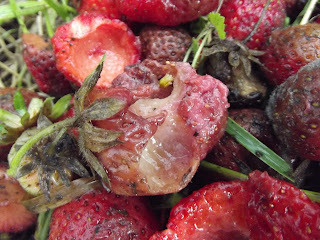Organic food doesn't use chemicals.
This is inarguable fact; organic certification standards are stringent. And it has several benefits; chemicals are not manufactured, not transported around the country/world, they don't pollute the soil and waterways, they don't harm the wildlife, they don't harm agricultural hired-hands in the fields, and they don't harm us. It's possible - perhaps likely - that organic produce may pick up other pollutants already in the environment or somewhere along the way to the supermarket shelf, but without the direct use of chemicals in its production, you are guaranteed to reduce your exposure by choosing organic food.
So I'd love to know why this week's headlines regarding a recent US study on organic foods proclaim that organic is "not healthier" than the alternatives.
If you've read these articles you'll have noted that despite the condemning headlines, they note that
organic food doesn't use chemicals, so choosing it reduces your exposure to pesticides, antibiotics and the like. Which is exactly the point of it. They also note that organic produce is less likely to be contaminated with bacteria, such as e-coli. More good news. So why the negative press?
Oh, apparently an organic carrot contains just the same nutrition as a non-organic carrot. So THAT's why it's not good for us! But hang on - did anyone actually think an organic carrot
was more nutritious in the first place? I've certainly never heard organics promoted that way, and the hundreds, perhaps thousands of comments on the news articles repeat the same sense of surprise again and again: we never thought it was more nutritious - we just don't want to eat chemicals! Are these media outlets missing the whole point deliberately, or is this lazy, thoughtless and misleading writing across the board just coincidence? With
the vote on labelling of GMOs in California approaching, the timing of this astounding attempted smear on organics certainly couldn't be better for big industrial producers such as Monsanto.
Roger Cohen of the New York Times went as far as to label "the organic ideology... an elitist, pseudoscientific indulgence shot through with hype" and driven by the "narcissism of the affluent". Yup.
Read it here. Bizarrely, he did actually note that
organic food doesn't use chemicals, as well as some other benefits, while claiming it was a cultish fad of no use to the world. Again, is he missing the point deliberately, or is he just stupid? Does he have shares in big ag? Or a particularly nasty grudge against a hippy somewhere? Can anyone tell me how the desire to eat food not tainted with toxic chemicals is pseudoscientific? Thought not. He goes on to claim that only GMOs can end world hunger, ignoring the facts that GM crop yields are lower and GM crops are falling, one by one, to their self-created super-pests and super-bugs. And he obviously doesn't realise
just how much food can be grown in a small space with traditional organic methods.
As for affluence, elitism and narcissism... Sure, organic may be more expensive (not always; some items are the same price or just a few pence more than their organic counterparts these days), but these accusations outright insult all those working hard to grow their own organic produce for a fraction of the prices in the shops. I don't always buy organic, but I won't be labelled a snob because I support it, I grow it, and I choose it when I can. The world has thrived without industrial chemicals for thousands of years and I reject the idea that pouring poisons on it now can possibly be a good thing.
Admittedly, some of the articles do raise one negative effect of organics; apparently organic meat and grain production produces slightly more greenhouse gasses. Not good news, but with a choice between further chemically polluting the earth or increasing greenhouse gasses, it seems to me we're avoiding the real issue; our overconsumption of meat and grain (consider how much grain is grown for animal feed, junk foods and alcohol production).
The Huffington Post got it right, eventually, sort of, in one little blog post which you can read
here.
So kids, if you want more nutrition, eat less junk and fill the gap with more fruits and vegetables of all the colours in the rainbow, and add some undomesticated wild greens such as nettles to your diet too - they tend to be far richer in vitamins and minerals. But if you want to reduce your exposure to pesticides, fungicides, chemical fertilisers and systemic herbicides, eat organic. Because
organic food doesn't use chemicals.
EDIT: There's
an excellent article here examining the study a bit closer, which exposes some rather significant and misleading flaws. Do take a look.




















































